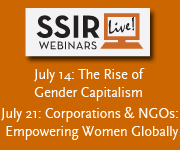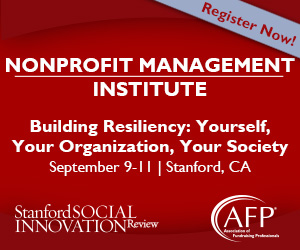ISSUE
Articles on social change from the latest edition of SSIR

Fall 2009
Volume 7, Number 4
Sometimes the traditional philanthropic models just aren’t enough. Enter “catalytic philanthropy” and the innovative donors who make it their mission to create real change. In the fall 2009 issue of Stanford Social Innovation Review, meet the ambitious and mission-driven philanthropists who do much more than write checks. By becoming directly involved and taking personal responsibility these donors form alliances, influence behavior, and make a real difference.
Features
Recreating Fine Arts Institutions
The fine arts in America are on a perilous path. Attendance at opera, theater, jazz, symphony, and ballet performances has dropped precipitously in recent decades. Just as worrisome, the median age of people attending these events has increased dramatically. If the fine arts are to survive as a living, creative, and significant force in American life, arts institutions need to radically recreate themselves.
Public-Private Alliances Transform Aid
The dual goals of scalability and sustainability have eluded many development projects. In recent years, however, the United States Agency for International Development (USAID) has reached out to corporations, nonprofits, and even private citizens to build alliances that are making large-scale, long-term change. In this article, the former head of USAID describes the public-private partnership model that his agency forged, the successes that the model has won, and the struggles that it continues to face.
The Nonprofit Starvation Cycle
A vicious cycle is leaving nonprofits so hungry for decent infrastructure that they can barely function as organizations—let alone serve their beneficiaries. The cycle starts with funders’ unrealistic expectations about how much running a nonprofit costs, and results in nonprofits’ misrepresenting their costs while skimping on vital systems—acts that feed funders’ skewed beliefs. To break the nonprofit starvation cycle, funders must take the lead.
Catalytic Philanthropy
Despite spending vast amounts of money and helping to create the world’s largest nonprofit sector, philanthropists have fallen far short of solving America’s most pressing problems. What the nation needs is “catalytic philanthropy”—a new approach that is already being practiced by some of the most innovative donors.
What's Next
In Their Own Words
A social media campaign aims to increase awareness of areas that reduce health risks for domestic workers and employers alike.
Embracing Practical Solutions
A $25 baby warmer might stop the tragedy of 450 low-birth-weight babies dying every hour in the developing world.
Banking on Change
Express Credit Union reopens in Seattle to serve the unbanked, underbanked, and want-to-be-banked.
Putting More Fun into Play
In a new playground in Manhattan, "play associates" will encourage youthful creativity while reminding parents and nannies to take a giant step back.
Field Report
Behind the Curve
Corrupt governments cash in on the Millennium Challenge Corporation’s outdated metrics.
The Answer Is on the Ground
The solutions to seemingly impossible problems already exist in the communities facing those problems.
Funding the Future in China
Qifang, an online peer-to-peer lending platform, expands access to education for the world's largest student population.
The Entrepreneurial Union
Freelance workers, whose numbers are growing, are left without health insurance, a retirement plan, or a work community. The Freelancers Union meets these needs.
Case Study
A Fine Green Niche
Maria Yee established her eco-friendly, high-end furniture company long before going green was the done thing. Two decades later, her company's environmentally sound practices not only reflect a planet-friendly ethos, but also drive a market-friendly creative edge.
Viewpoint
The Madoff Philanthropic Implosion
With many in the community losing their savings in the Madoff scandal, Jewish philanthropies took a hard hit.
Great Teachers on the Fast Track
To save the nation, the United States needs alternative teacher training.
A Nature State of Mind
True restoration—environmental and economic—will not come from congressional legislation, top-down stimulus money, or EPA rulings.
A Light in City Hall
How one newcomer to the Los Angeles mayor’s office mixed government with philanthropy to make change.
Research
Medicare Saves Lives
Patients insured by Medicare are less likely to die within a week of hospital admission than their slightly younger counterparts.
Diversity Brings the Dollars
More diverse workplaces have higher revenues, more customers, larger market shares, and greater relative profits.
Why They Stayed
New research reveals the economic hardships that Katrina's "stayers" were battling and the abundance of negative opinions about them.
How to Survive the Recession
The current recession has left few nonprofits unscathed and has hit theaters particularly hard. Creative entrepreneurial changes have proven more effective than the traditional belt-tightening.
It’s Not About the Work Ethic
Protestants' work ethic is a product of the denomination's emphasis on education.
Books
Good Guy vs. Good Guy
Conservation Refugees: The Hundred-Year-Conflict Between Global Conservation and Native Peoples by Mark Dowie
The House That BRAC Built
Freedom from Want: The Remarkable Success Story of BRAC, the Global Grassroots Organization That's Winning the Fight Against Poverty by Ian Smillie
Q&A
Q&A: Fred Krupp
Under Fred Krupp’s leadership, the Environmental Defense Fund has become one of the most important power brokers in the environmental arena. Krupp has helped accomplish what some thought was impossible—getting businesses to go green voluntarily.
 → This form is for US/Canada subscribers. Are you an international subscriber?
→ This form is for US/Canada subscribers. Are you an international subscriber?
Click here instead.
Subscribe Now!
Subscribers get premium online access (articles with a key) including 9-year archive, downloadable digital edition, quarterly print issues (optional).











































































